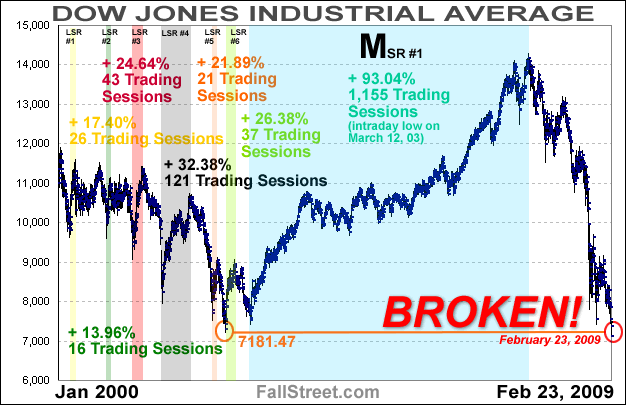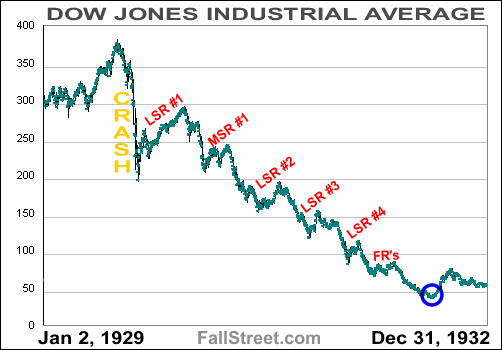

According to GASRP (Generally Accepted Sucker Rally Principles) there have been 6 Large Sucker Rallies (LSRs) since the current bear market began, and 1 Mammoth Sucker Rally. Additionally, there have been multiple Failed Rallies (FRs) and many notable Mini-Sucker-Rallies (not noted in the above chart).
Methodology of a Large Sucker’s Rally
1) The Dow must begin to rally from a new 52-week low or below its previous Large Sucker Rally Bottom (LSRB).
2) The Dow must fail to recapture its previous Large Sucker Rally Top (LSRT).
Methodology of a Mammoth Sucker’s Rally
1) Previous LSRT is broken to the upside.
Current Sucker Forecast
February 24, 2009: The Dow briefly broke below its March 12, 2003 bottom on November 11, 2008 and again on February 20, 2009. However, the decisive blow only arrived yesterday when the Dow busted below both its March 12, 2003 low and the previous bear market low of 7,181.47. Despite attracting countless suckers during its nearly 100% record romp, yesterday’s close is confirmation of MSR #1. Yesterday also confirms that the markets are battling a secular, not a cyclical, bear…
With a new LSRB in place and a new LSRT more than 7,000 points away, look for more than a few LSRs to transpire before the current bear market is over. Incidentally, consultations with FASB (First Authoritative Sucker Board) and the SEC (the Sucker Efficiency Club) are underway to determine whether or not the brief rally from November 11, 2008 to January 6, 2009 (+13.8% intraday) warrants inclusion as LSR # 7.
Historical Sucker Updates
September 6, 2006: It has been nearly 3-years since the last update, and, remarkably, nothing has changed: until the Dow breaks new ground on the upside there remains the possibility that the current rally will end up being a prolonged MSR.
In order for the Dow to form a MSR it would have to fall by more than 4,000 points from current levels, and for the Dow to hit new highs the average would have to rally by 439.23 points. Clearly the odds say that it sucks to be a sucker-rally-enthusiast (SRE) today.
Perhaps it is prudent to take off the Armageddon-glasses, back away from Dow 7K speculations, and focus on expanding GASRP standard to better deal with the next major market correction. But alas, with any potential changes to GASRP likely to be overruled by Congress, we are compelled to keep up the norm. Norm says that a 35.5% decline in the Dow - what would be required for the Dow to test its March 12, 2003 low - is not unthinkable when the great secular bear market resumes.
December 23, 2003: Despite breaking its previous LSRT, the Dow remains well below its Bull Market Top. Accordingly, the only sucker forecast to be made is that a mammoth trading range (MTR) is now in place -- 7181 is the low while 11,908 (Jan 14, 2000) is the high.
Not unlike the 1966-1982 period – wherein the Dow repeatedly failed to hold above 1,000 – the Dow could be embarking upon a similar long-term battle with 10,000 today. Even so, long-term stagnation in the Dow is not the same thing as a sucker’s rally. Rather, if the Dow really reached its Bear Market Low in October 2002, the sucker rally comparisons that can be made to similar periods (1929 being the example) are now complete.
May 16, 2003: “The Dow did not begin its current MSR from a new LSRB. As such, the Dow is in a trading range, and will fail to find enough new suckers to surpass its LSRT of 9076.” Result: Enough new suckers were found: on June 4, 2003 the Dow broke its previous LSRT (9076.35) on an intraday basis.
October 12, 2002: “Taking into account the last 5 SRs, the Dow will gain 22.05% over the next 45.4 Trading Sessions.” Result: It took the Dow only 37 sessions to gain 21% on a closing basis during LSR #6.
All data and information within these pages is thought to be taken from reliable sources but there is no guarantee as such. All opinions expressed on this site are opinions and should not be regarded as investment advice.
Copyright © 2000-2009
FallStreet.com